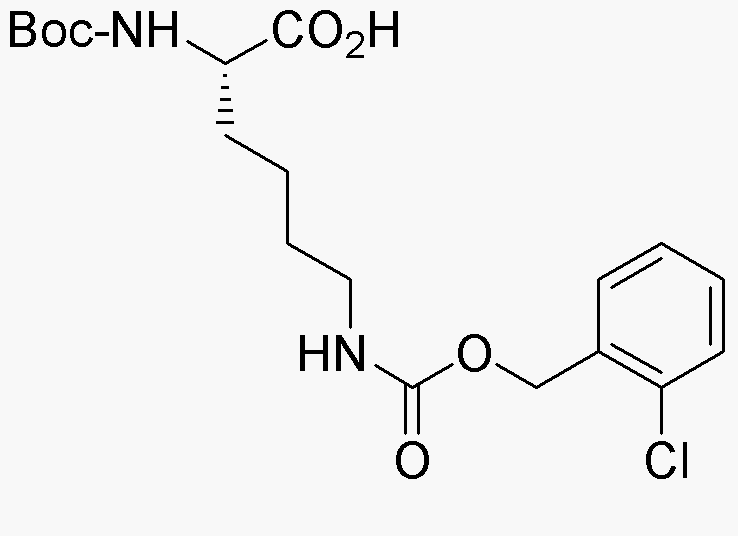Na-Boc-Ne-2-chloro-Z-L-lysine is widely utilized in research focused on:
- Peptide Synthesis: This compound serves as a key building block in the synthesis of peptides, particularly in the development of pharmaceuticals. Its protective groups allow for selective reactions, enhancing the efficiency of peptide assembly.
- Drug Development: It plays a significant role in the creation of novel therapeutic agents. By modifying the lysine residue, researchers can improve the pharmacological properties of drug candidates, leading to more effective treatments.
- Bioconjugation: The compound is used in bioconjugation processes, where it helps attach drugs or imaging agents to biomolecules. This application is crucial in targeted drug delivery systems, enhancing the specificity and efficacy of treatments.
- Research in Protein Engineering: It aids in the design of modified proteins with enhanced stability and activity. This is particularly beneficial in the fields of biotechnology and enzyme engineering, where tailored proteins can lead to innovative solutions.
- Analytical Chemistry: The compound is utilized in analytical methods for studying amino acid sequences and modifications. Its unique structure allows for precise identification and quantification of peptides in complex mixtures.
General Information
Properties
Safety and Regulations
Applications
Na-Boc-Ne-2-chloro-Z-L-lysine is widely utilized in research focused on:
- Peptide Synthesis: This compound serves as a key building block in the synthesis of peptides, particularly in the development of pharmaceuticals. Its protective groups allow for selective reactions, enhancing the efficiency of peptide assembly.
- Drug Development: It plays a significant role in the creation of novel therapeutic agents. By modifying the lysine residue, researchers can improve the pharmacological properties of drug candidates, leading to more effective treatments.
- Bioconjugation: The compound is used in bioconjugation processes, where it helps attach drugs or imaging agents to biomolecules. This application is crucial in targeted drug delivery systems, enhancing the specificity and efficacy of treatments.
- Research in Protein Engineering: It aids in the design of modified proteins with enhanced stability and activity. This is particularly beneficial in the fields of biotechnology and enzyme engineering, where tailored proteins can lead to innovative solutions.
- Analytical Chemistry: The compound is utilized in analytical methods for studying amino acid sequences and modifications. Its unique structure allows for precise identification and quantification of peptides in complex mixtures.
Documents
Safety Data Sheets (SDS)
The SDS provides comprehensive safety information on handling, storage, and disposal of the product.
Product Specification (PS)
The PS provides a comprehensive breakdown of the product’s properties, including chemical composition, physical state, purity, and storage requirements. It also details acceptable quality ranges and the product's intended applications.
Certificates of Analysis (COA)
Search for Certificates of Analysis (COA) by entering the products Lot Number. Lot and Batch Numbers can be found on a product’s label following the words ‘Lot’ or ‘Batch’.
*Catalog Number
*Lot Number
Certificates Of Origin (COO)
This COO confirms the country where the product was manufactured, and also details the materials and components used in it and whether it is derived from natural, synthetic, or other specific sources. This certificate may be required for customs, trade, and regulatory compliance.
*Catalog Number
*Lot Number
Safety Data Sheets (SDS)
The SDS provides comprehensive safety information on handling, storage, and disposal of the product.
DownloadProduct Specification (PS)
The PS provides a comprehensive breakdown of the product’s properties, including chemical composition, physical state, purity, and storage requirements. It also details acceptable quality ranges and the product's intended applications.
DownloadCertificates of Analysis (COA)
Search for Certificates of Analysis (COA) by entering the products Lot Number. Lot and Batch Numbers can be found on a product’s label following the words ‘Lot’ or ‘Batch’.
*Catalog Number
*Lot Number
Certificates Of Origin (COO)
This COO confirms the country where the product was manufactured, and also details the materials and components used in it and whether it is derived from natural, synthetic, or other specific sources. This certificate may be required for customs, trade, and regulatory compliance.


